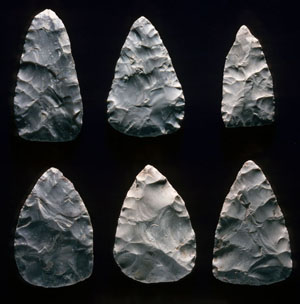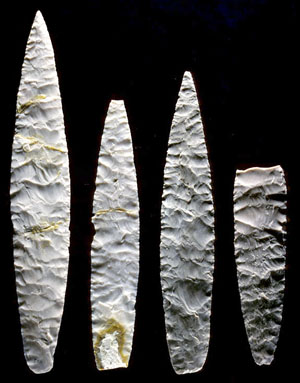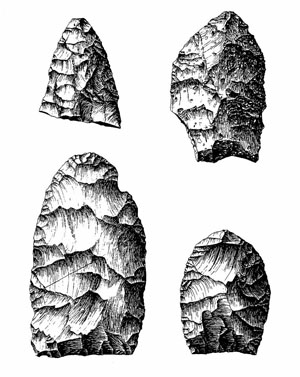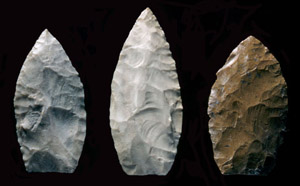Biface Caches
Biface caching is an intriguing prehistoric pattern on the South Texas Plains. Such caches consist of purposefully hidden ("cached," usually buried) groups of large, well-made, percussion-shaped, symmetrical bifaces. Cache bifaces typically have no evidence of use, resharpening, notching or other evidence of specific function. Most are well suited for being turned into large knives or very large spear and dart points, but they were left in pristine form. Most commonly found in the South Texas Plains are triangular cache bifaces, but forms can range from ovate to lanceolate in outline. Such artifacts are sometimes called “trade blanks” or “quarry blanks,” but the biface caching pattern is more than mere trade in tool-making stock.
The biface caches discussed here are isolated finds. Such caches are distinct from, at least to some extent, clusters of bifaces (some of which are of cache bifaces) found at some cemetery sites (see Loma Sandia and Silo). The bifaces selected to be mortuary items placed with a particular individual are grave offerings. Other clusters or caches of bifaces found at cemetery sites are not directly associated with a grave, but may still represent ritual offerings as well as hidden or stored items intended for other purposes. Most of the biface caches discussed here are those that are not found in cemetery contexts.
Most cache bifaces are made of Edwards Chert and were traded into south Texas from on or near the Edwards Plateau in central Texas. Though large chert cobbles of Uvalde gravels do occur in the South Texas Plains, mainly in hilltop exposures, these are not common. (See "Uvalde" gravel entries in the Rock Gallery.) Most pieces of chert found in Uvalde gravel exposures are unsuitable for the manufacture of cache bifaces, especially sets of bifaces made of uniformly good-quality materials. Along the lower Rio Grande, caches with mostly smaller, thinner bifaces have been found that contain specimens that appear to have been made from local gravel outcrops.
We do not yet know much about the mechanisms of the biface trade. A broad study of Texas biface caches by Kevin Miller indicates these types of biface caches, made of Edwards Chert, occur in some numbers east of Austin and into east Texas.
Caches of other stone tool forms have also been found in the South Texas Plains, especially those of the distinctive Guadalupe adze, which dates to the Early Archaic period. Archeologist Ken Brown has reported several of these caches. The Guadalupe tools found in these caches have use wear and are clearly utilitarian artifacts, probably used in wood-working. They are thought to have been were cached, or perhaps “curated” is more appropriate, for later use by their owner. See Woodworking Tool Tradition to learn more about Guadalupe Tools.
Most biface caches on the South Texas Plain appear to date from Late to Transitional Archaic in age. There are, however, at least two known caches from the South Texas Plains that could well date to late Paleoindian times.
The Kothmann Ranch Cache of three long, lanceolate bifaces comes from the San Miguel Creek drainage in Frio County, Texas. According to the late Dr. Pat Riley, whose family owned the ranch at one time, this cache was found between 1929-1934. Unfortunately, no further details are known; Riley kept the cache together for several decades, and it was ultimately donated to the Texas Archeological Research Laboratory (TARL) by his family in the 1990s.
The bifaces range in length from 22 cm (9”) to 29 cm (11.5”), in maximum widths from 3.8-4.8 cm, and thickness, around 5-7 mm. Thus, they are very large, very thin, and exceedingly well flaked. Two of the specimens on which all cortex has been removed are perhaps the most “finished” and have intentional dulling (edge grinding) along the lower edges – dulling of the sort that is typical of Paleoindian lithic bifaces. There is also scattered dulling along the middle lateral edges of the largest specimen, and this may reflect edge preparation during final flaking. Flaking patterns are primarily parallel to slightly parallel oblique. Note that one specimen has a patch of cortex near its base; we will come back to this in some later observations.
The largest specimen is broken in three places, and the smallest has a single break, although its tip and a small part of its base are also missing. The other specimen, of grayish-brown chert, is unbroken; it also appears to be the most finished, with lateral edge grinding and a biconvex cross section. There are no plow-strikes on the bifaces. They may have been found eroded onto the surface and broken post-deposition. On the other hand, it is possible that two of the specimens were intentionally broken.
Overall, the Kothmann Ranch bifaces have the outline typical of point styles called Angostura in Texas, and which have been dated during the 1990s to about 7000 B.C. Supporting this antiquity is a broken biface of this style excavated in 1971 at the base of the deposits at the La Jita site in Uvalde County.
In 1998, David Calame was able to obtain information about a cache of two elongated bifaces from far northern Frio County. Like the Kothmann Cache, it was also found along the San Miguel drainage. These specimens, known as the Knothole Cache, were found about 1973 by workmen digging a garbage pit; they brought them to the attention of the ranch owner, who did further excavation at the find spot, but found no additional specimens. Calame photographed and documented the bifaces, although these were glued down to a display board.
The largest specimen is very similar in outline to the Kothmann Cache. It is 33.5 cm long (over 13 inches), 5.5 mm wide, and 5-7 mm thick. There is cortex at the base, as on one Kothmann specimen. Prepared platforms can be seen along the lateral edges and there is some edge-dulling that appears to be related to the reduction process. The flaking is carefully done, mostly parallel, with deep parallel flakes near the base. The second specimen is 27.5 cm long (11 inches), 5.3 cm wide, and about 6.5 mm in average thickness. It has cortex at the base, where is it straight or flat. The distal portion has short parallel to parallel oblique flakes, and broad percussion flakes on the lower half. Interestingly, parts of the edges of both bifaces are lightly serrated.
The Kothmann Ranch and Knothole Caches are remarkably similar, and the similarity is shared by the lanceolate biface from the base of the La Jita site in Uvalde County, roughly 50-60 miles to the northwest. It is possible that these caches represent the Angostura equivalent (i.e., terminal Late Paleoindian or Early Archaic in age) of the Clovis caches of earlier times, a well known phenomena. While no Clovis caches with large unfinished Clovis bifaces, have yet been found in south Texas, they are well known from the western United States (East Wenatchee in Washington State, Simon in Idaho, Drake in Colorado) as well as other areas of Texas. Clovis caches, sometimes quite large, are also known of blades and blade cores, suggesting that stone tool caching was a characteristic pattern of the times.
Most of the other biface caches known from the South Texas Plains appear to date to the latter part of the Archaic era. The Riley Cache, was discovered in 1929 in southwestern Medina County and consists of 29 medium-sized bifaces. Kevin Miller has reported the details of this cache. How the cache was found is a story all by itself.
A young boy and his dog were hunting rabbits along a creek that drains into the Atascosa Creek southwest of the town of Lytle. They chased a rabbit into its burrow, and the boy began digging at the hole, trying to get the animal. It isn’t known if the rabbit was found or escaped, but the boy did uncover 29 bifaces that were buried in white creek-bed sand, apparently this sand had used as special fill in the presumed cache pit. The boy took his surprising find to a grocery store owner in Lytle to trade the artifacts for groceries. They were later acquired from the store owner by an uncle of Dr. Pat Riley, who kept the specimens together for almost 50 years. Like the Kothmann Ranch cache, the Riley Cache is curated at TARL, where it can be studied by researchers.
The Knothole specimens are quite uniform in technology, shape and size. The cherts of which they are made vary somewhat in color (different shades of brown, including chocolate brown, and light to dark gray). By examining the UV fluorescence of the bifaces, Michael Collins found that all are were of the distinctive yellowish orange color thought to be typical of Edwards chert.
Biface shapes within the Knothole Cache can be characterized as “sub-triangular,” with some specimens distinctly triangular and others ovate in outline. Miller describes the Riley Cache bifaces as “blanks” typical of many of the caches that he has examined. However, he thinks one specimen has evidence of use, perhaps as a cutting tool. Miller believes that all had been made by soft-hammer percussion, with some of the specimens originally made on large flakes and others reduced from chert nodules. The mean length of the 29 specimens is 100.8 mm, mean width, 69.1, and mean thickness, 10.2 mm. In aggregate, they weigh 5.7 pounds.
Bifaces quite similar to those from the Riley Cache were found among a cache of eight bifaces found on the Mexican side of Falcon Lake during the 1990s, when the water level in the lake was 30-40 feet low. As reported by Chandler and Kumpe, the Falcon-Tamaulipas Cache consisted of stacked bifaces, the two largest of which were said to have been carefully placed in a crisscross pattern at the top of the stack. The upper three were visible on the surface, and the discoverer found the others tightly stacked beneath them. Ultra-violet fluorescence of the cache revealed that 7 of the 8 were of Edwards chert, the source of the eighth is unknown. Six of the bifaces, all of Edwards chert, were typified by white speckled inclusions, identified as Cretaceous-age fossil shells.
Chandler and Kumpe also described the Roma Cache, a cluster of four thin triangular bifaces found by Kumpe in 1967 near the town of Roma in Starr County. Rains from a hurricane had exposed the walls of a narrow wash, and exposed the bifaces, which appeared to have been cached under a rectangular sandstone slab. Kumpe believes that other bifaces were probably present, buried deep in the wall of the gully. These bifaces are basically triangular in shape. Interestingly, two otherwise complete bifaces were each found in two pieces; they appear to have been intentionally broken by diagonal breaks near mid-section. The two other specimens were fragmentary, one was a distal section and the other had a broken corner. None of the Roma Cache artifacts was made of Edwards chert. Chandler and Kumpe describe these as “olive-gray grainy cherts”, a reddish conglomerate, and “white chert,” which suggests that they are from local sources, probably the Rio Grande gravels.
While the Falcon-Tamaulipas Cache is typical of south Texas biface caches, there may be additional behavior seen in the Roma Cache. The bifaces in this cache may well have been “killed” –intentionally broken for ritual purposes—before they were deposited.
The Falcon-Scott Cache is an unusually large set of bifaces from Falcon Lake, this time in Zapata County. This cache, documented by James Boyd, consists of 48-52 bifaces found with a burial at site 41ZP7. The count is indefinite because the cache was found by collectors and was not kept together; not all were formally documented. Although this cache is a grave offering, it is by far the largest group of cache bifaces found in any context in the region. All of the specimens are made of Rio Grande gravels (see Rock Gallery), except for a stemmed biface which fluoresces as Edwards chert. This atypical specimen is of great importance, because the style is fairly common in central Texas and dates to the Late Archaic. Although not formally “typed,” these bifaces are often referred to as ”San Saba Knives,” based on studies of similar specimens from San Saba County, published in 1972 by Hester and the late avocational archaeologist L. M. Green of Richland Springs.
Why Caches?
How can we explain the caches of large bifaces that have been reported in various parts of the South Texas Plains? This distinctive pattern spans thousands of years. Across the region, the age of documented biface caches and mortuary offerings involving large bifaces ranges from the Middle Archaic (Loma Sandia) into the Transitional Archaic (Silo). There are a smaller number of much earlier biface caches that seem to date to the onset of the Early Archaic, or perhaps even as early as Late Paleoindian times.
Kevin Miller suggests that caches could have been raw material stockpiles or “insurance” for further needs, as well as sources of material for ritual or status demands. Perhaps the isolated caches that have been found are examples of stock piles that, for reasons unknown, were never returned to by the “owner.” In this scenario, most cache bifaces would have been subsequently distributed, through trade, to other peoples on the South Texas Plains, either to be finished and used as knives, or left as “blanks” and used as mortuary offerings. As Chris Lintz and Bryant Saner, Jr. have stated, “archaeologically recovered caches present static snap-shots of a dynamic prehistoric process of assembling, using, and dispersing a mass of goods that are regarded as useful.”
Lintz and Saner suggest that cache bifaces may well have been used in many different ways. This include the use of cache bifaces as cores or preforms, as mortuary offerings, in other types of rituals, to symbolize status, and for utilitarian uses, some quite specific. An example of the latter is a large, thin biface from the Shrew site in Wilson County that was found to have extensive use wear related to the cutting of grasses and plants. Another very large cache biface found as a single occurrence in Starr County near Falcon Lake may represent an item that was “pulled” from a cache to be used in some specific way.
While archeological clues are often lacking as to exactly how cache bifaces were used, there is one extraordinary set of first-hand ethnographic observations, that of Alvar Nunez Cabeza de Vaca in the mid-1530s. While among the Avavares peoples of south Texas, Cabeza de Vaca learned of a mythical incident involving Mala Cosa (“the Bad Thing”), a strange little man who used a big flint knife up to two palms long and a hand wide to cut the Avavares (sometimes removing their intestines, but then healing the wound). Large flint bifaces were given by the Cutalcuches as gifts to Cabeza de Vaca. He noted that this group used such artifacts which he described as being up to a palm and a half long. These were prized belongings, yet were also used for cutting tasks. Cabeza de Vaca made these intriguing references to large bifaces while describing time spent with Avavares and the Cutalcuches, who shared a prickly pear harvesting area in Duval or Jim Hogg County in summer of 1535 .
What is the length of a biface calculated at l ½ or 2 palms? Sixteenth century Spanish measurements are inconsistent. A palmo is thought to have been about 20 cm (8 inches). This, however, is the palmo mayor, while a palmo menor was about 7 cm. We don’t know what measurement value Cabeza de Vaca attached to his palmo, but certainly there are cache and mortuary bifaces in south Texas that are at least a “palm” or more in length.
When referring to the “trade” or “exchange” of lithic bifaces, we are assuming that it was this type of mechanism that brought many of the cache bifaces from the Plateau and Canyonlands of central Texas to the South Texas Plains. Miller has mapped the distribution of biface caches emanating from the Edwards Plateau, and extending into south Texas, as well as far into east Texas. It has been established that most of the raw material in these caches is from the Edwards Plateau. Certainly, the peoples of south Texas, who normally made use of the typically hard, flawed, and small materials found in the Uvalde and Rio Grande gravels, would have wanted to acquire bifaces of high quality chert. But what could they have offered in exchange?
North of the Balcones Escarpment along the southern edge of the Edwards Plateau, there are very few (if any) documented stone artifacts, or artifacts of any other non-perishable material, that appear to be items that originated in “trade” from southern Texas. Therefore, we have to assume that if such exchanges were made in acquiring these bifaces, the goods were of a perishable nature. Again the most telling evidence comes from Cabeza de Vaca.
Krieger’s account of Cabeza de Vaca’s interactions with south Texas Indian groups indicate that foodstuffs were commonly exchanged (e.g., prickly pear fruits, mesquite bean flour; meat), and that the Spaniard traded with the Indians by making them combs, bows and arrows, mats, and nets. During his years among coastal Texas groups, de Vaca served as a trader. He took “shells of sea snails and their cores," conches (“with which they cut...”), a fruit or bean (still unknown) that was both for cures and for dances and celebrations, and “sea beads.” The fruits or beans were the items of greatest value. These were exchanged with interior groups for hides, red ochre, flint for arrow points, glue, canes for arrow shafts, and tassels of deer hair that had been dyed red. This account serves as an example of an active trade network between the coast and the interior of the South Texas Plains. The larger trade network between the Edwards Plateau and the South Texas Plains may well have involved chert of high quality from the Edwards Plateau (in large biface form). Whether the Edwards Plateau peoples would have been interested in hides, ochre, cane, and deer-hair tassels is hard to say, but there may have been some commodities among these (and other perishables) that were valued by them. See Distant Connections.
Contributed by Thomas R. Hester.
Sources
Chandler, C. K. and Don Kumpe
1996 Lithic Caches from the Lower Rio Grande. La Tierra 23(4):37-41.
Hester, Thomas R. and L. M. Green
1972 Functional Analysis of Large Bifaces from San Saba County, Texas. Texas Journal of Science XXIV(3):343-350.
Hester, Thomas R. and William Wilson
2004 A Trade Blank from the Lower Rio Grande: Further Observations
On Large Biface Exchange in Southern Texas. La Tierra 31(1):1-4.
Hester, Thomas R. and David L. Calame, Sr.
2003 Variability Among Biface Caches from Southern and South Central Texas.
La Tierra 30 (3&4):25-36.
Krieger, Alex D.
2003 We Came Naked and Barefoot. The Journey of Cabeza de Vaca Across North America. Edited by Margery H. Krieger. University of Texas Press, Austin.
Labadie, Joseph H.
1988 Archaeological Excavations at the Shrew Site, 41WN73, Wilson County,
Texas. Contract Reports in Archaeology 2, Texas State Department of
Highways and Public Transportation, Austin.
Lintz, Christopher and Bryant Saner, Jr.
2002 The Hoerster Cache from 41MS67, Mason County, Texas. La Tierra 29(1):12-47.
Miller, Kevin A.
1993 A Study of Prehistoric Biface Caches from Texas. Unpublished MA thesis, University of Texas at Austin.
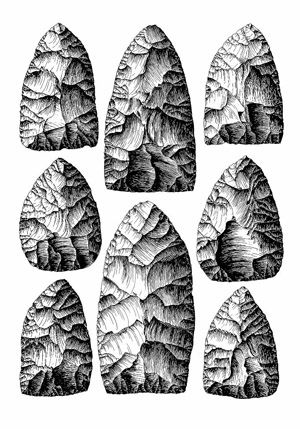
|
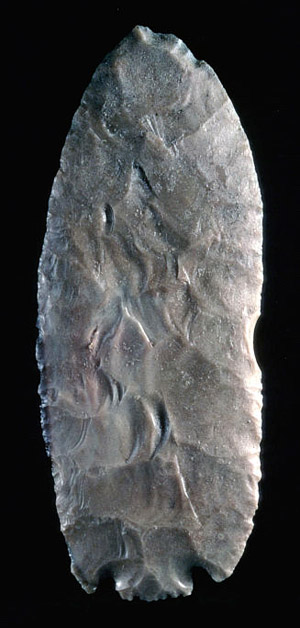
|
